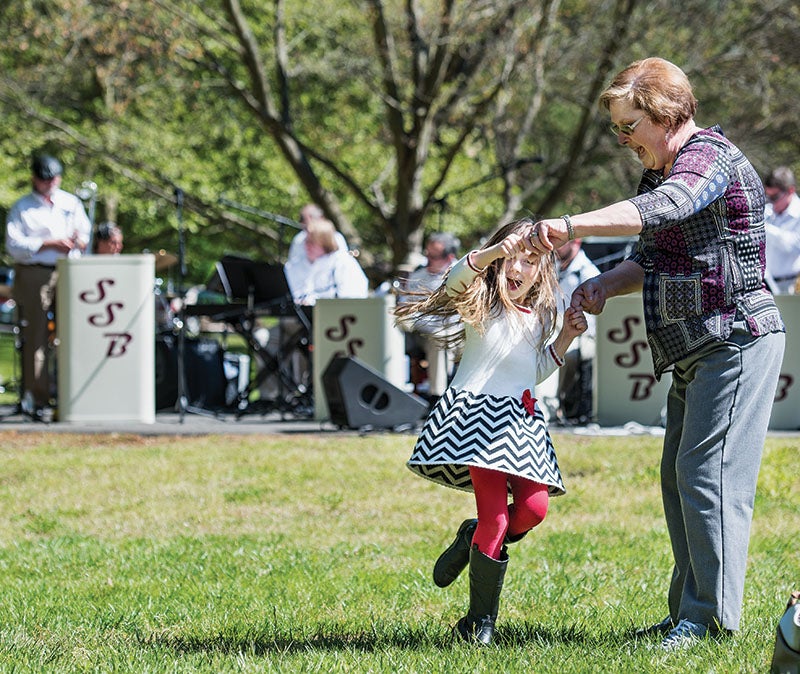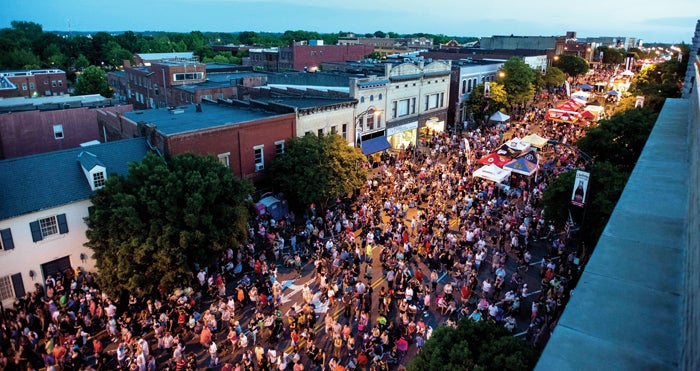‘Not ours, but yours’: Hurley Park has fulfilled its vision of being a people’s park
Published 12:10 am Friday, March 31, 2017

- ALLISON LEE ISLEY/SALISBURY POST file photo Claire Paskiewicz, 5, dances with her grandmother, Kathy Haynes, to the Salisbury Swing Band during last year’s Hurley Park Spring Celebration.
SALISBURY — When the Japanese attacked Pearl Harbor Dec. 7, 1941, and threw the United States headlong into World War II, Elizabeth Holmes Hurley was upset, even angry.
The story goes she retrieved an ax, walked into her yard off Club Drive and, not unlike one of the legends behind George Washington, chopped down a cherry tree — one she had planted.
It was a Japanese cherry tree, you see.
The late Jimmy Hurley shared that anecdote at the April 10, 1988, dedication of Elizabeth Holmes Hurley Park, the beautiful 18 acres of gardens, streams, paths and woodlands off Lake Drive and Annandale Avenue.
Jimmy promised the family would plant a new cherry tree in the park later that fall.
Sunday, from 2-4 p.m., will mark the 30th spring celebration at Hurley Park. The day also falls on the fifth anniversary of Jimmy Hurley’s death, and there might not be a better way to remember him than to attend the park celebration.
Jane Ritchie was the landscape architect behind Hurley Park, and she knows the interest Jimmy took in this family tribute to his mother, who died in 1985.
Hurley was always driving through the park on the way home or heading to work at the Salisbury Post, often stopping to talk with Ritchie during its development stages. Back then the construction included a new pond and observation deck, bridges, gazebos, paths, irrigation lines, granite curbing, parking pockets, trash receptacles, benches and rows and collections of new trees.
There’s more to a park’s infrastructure than you might imagine.
Jimmy and wife Gerry would take Sunday walks over the grounds, picking up any trash they might come across. Ritchie was forever updating Hurley on the gardens and infrastructure planned because he was wholly vested in the park and would be until his death.
Ritchie and curators such as Margo McIntyre and Daphne Beck appreciated Hurley’s interest.
Ritchie remembers standing in the park with Hurley during a rainstorm once so they could check out some drainage issues.
Hurley often offered ideas, expressed concerns or conveyed any complaints he heard from nearby residents. He was never overbearing, Ritchie says, and he usually gave in to the curators’ assurances that nature and growth would take care of many things.
“It was a project close to his heart,” says Ritchie, who has remained devoted to the park herself. “He cared about it a lot.”
J.F. Hurley Jr. and his sons, Jimmy, Haden and Gordon, always wanted the park named for Elizabeth to be a “people’s park,” as first envisioned by then Mayor Wiley Lash.
Lash had visited a similar park in Cleveland, Ohio, where people had donated the money for trees, shrubs and whole gardens in memory of loved ones. Lash recommended a similar approach for a passive park, then being referred to as Annandale Park, which was being considered on bottom land between City Park and the hospital.
The Hurley men made the park a reality by establishing a foundation with more than $200,000 of seed money and setting up a partnership with the city for its growth and maintenance.
It was inspired in part by Memorial Gardens in Concord, where the Hurley sons’ grandparents are buried. Sallie Phifer Williamson had revived those gardens after they fell into neglect, and her son, Marshall, went on to establish a trust fund to maintain them.
The concept appealed to Elizabeth Hurley, and the Hurley men remembered her admiration for the Concord gardens and the trust fund approach after her death. Despite her incongruous attack on the Pearl Harbor cherry tree, Elizabeth Hurley loved flowers and growing things.
For almost 30 years, Hurley Park has been a great study on how a private-public partnership works. The private foundation gave a generous gift and also serves as a vehicle for accepting other donations. It combined nicely with the city’s manpower, administrative expertise and the volunteer leadership of an active advisory committee.
“I guarantee you that, as long as we live, this park will not go to pot,” Hurley told the dedication crowd back in 1988. ‘”Nor will it become a burden on the city. Yet we do not want it to be ours, but yours.”
Since 1988, many gardens, trees and furnishings have been dedicated at the park in memory of individuals or groups. Contributions of varied amounts also are routinely made to the park to help with its long-term care.
Hurley Park has become a favorite place for weddings, prom pictures, informal gatherings and walking programs. But mainly it’s a passive park, one in which visitors enjoy the sights and fragrances of every season at a leisurely pace.
It’s an escape often taken in solitude and the perfect place for a park named for Elizabeth Holmes Hurley.
When she and J.F. Hurley Jr. built their house on Club Drive in 1935, it was the only one there. There was no City Park. Part of that land was a cornfield, and the rest was a bog, Jimmy Hurley once said.
Confederate Avenue was a dead-end drive, and their Club Drive was a dirt path.
Things changed drastically with the Depression-era construction of City Park by the Workers Progress Administration. WPA workers built a dam, which established the lake, When people started going to the park in droves, Club Drive was paved.
“Mother must have fixed 35,000 meals — breakfast and supper for 50 years — overlooking the park from our kitchen window,” Jimmy Hurley said.
So a park at this spot, honoring Elizabeth Holmes Hurley, just made sense, and Ritchie thinks it fulfilled the Hurleys’ hopes that it would become a beautiful place.
You can’t help but see Jimmy driving through, checking things out.
Contact Mark Wineka at 704-797-4263, or mark.wineka@salisburypost.com.





